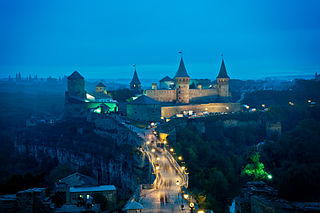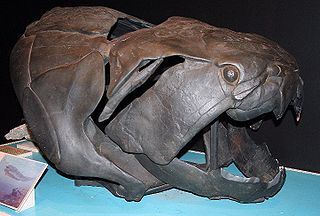
Dunkleosteidae is an extinct family of arthrodire placoderms. The gigantic apex predator Dunkleosteus terrelli is the best known member of this group. While they were previously thought to be close relatives of the genus Dinichthys and grouped together in the family Dinichthyidae, more recent studies have shown that the two taxa represent two very distinct clades within Arthrodira. The reappraisal of Kiangyousteus lead to a restructuring of the family, with the inclusions of the benthic, aberrant Heterosteus as the sister taxon of Dunkleosteus, and the Late Emsian Xiangshuiosteus as the sister taxon of Eastmanosteus calliaspis, and the removal of Westralichthys from the family

Jaekelopterus is a genus of predatory eurypterid, a group of extinct aquatic arthropods. Fossils of Jaekelopterus have been discovered in deposits of Early Devonian age, from the Pragian and Emsian stages. There are two known species: the type species J. rhenaniae from brackish to fresh water strata in the Rhineland, and J. howelli from estuarine strata in Wyoming. The generic name combines the name of German paleontologist Otto Jaekel, who described the type species, and the Greek word πτερόν (pteron) meaning "wing".

Homosteus is a genus of flattened arthrodire placoderm from the Middle Devonian. Fossils are found primarily in Eifelian-epoch aged strata of Europe, Canada, Greenland, and Estonia. All of the species had comparatively large, flattened heads with, as suggested by the upward opening orbits, upward-pointing eyes. These adaptations suggest that the various species were benthic predators.
Protaspis is an extinct genus of pteraspidid heterostracan agnathan which lived during the Early Devonian of the United States, with fossils found in marine strata in what is now Utah, Wyoming and Idaho.
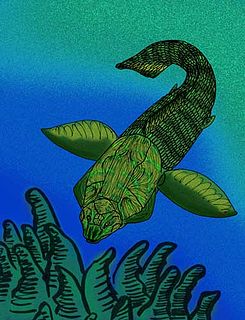
Holonematidae is an extinct family of relatively large arthrodire placoderms from the Early to Late Devonian. Almost all fossil specimens are of armor fragments, though, all have distinctive ornamentation, often of unique arrangements and patterns of tubercles, that are diagnostic of the family. The trunkshield is very elongated, giving the armor an overall "barrel" like appearance.

Buchanosteus is an extinct genus of arthrodire placoderm. Its fossils have been found in Early Devonian-aged marine strata throughout Asia and Australia. It contains the following species:

Homostiidae is a family of flattened arthrodire placoderms from the Early to Middle Devonian. Fossils appear in various strata in Europe, Russia, Morocco, Australia, Canada and Greenland.

Buchanosteidae is a family of arthrodire placoderms that lived from the Early to Middle Devonian. Fossils appear in various strata in Russia, Central Asia, Australia, and China.
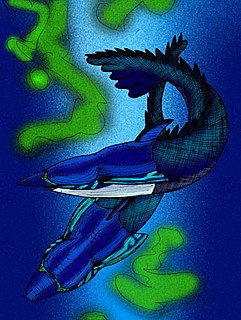
Panamintaspis snowi is an extinct species of pteraspidid heterostracan agnathan which existed during the early Middle Devonian period of Death Valley, California. Fossils are found in Late Emsian-aged marine strata of the Lost Burro Formation. P. snowi strongly resembles Pteraspis, though while it was originally described as a member of the same family, Pteraspididae, a recent phylogenetic reassessment of the order Pteraspidiformes places P. snowi within the paraphyletic family "Protopeteraspidae," as the sister taxon of the suborder Pteraspidoidei.

Cardipeltis is an extinct genus of heterostracan agnathan from marine strata of early Devonian of Utah, and Wyoming. Species of Cardipeltis superficially resemble those of cyathaspids in having a flattened body and indistinct head covered by a large, broad, guitar pick or heart-shaped dorsal shield, and a long, scaly tail. Unlike cyathaspids, which all have a single ventral plate, however, the ventral shield of Cardipeltis is a mosaic composed of large scales.

Pteraspidiformes is an extinct order of heterostracan agnathan vertebrates known from extensive fossil remains primarily from Early Devonian strata of Europe and North America, and from Upper Silurian Canada.
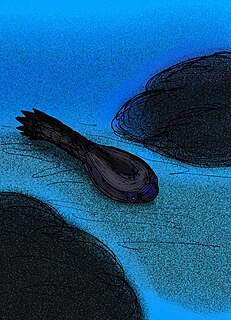
Cyathaspidiformes is an extinct order of heterostracan vertebrates known from extensive fossil remains primarily from Silurian to Early Devonian strata of Europe, and North America, and from Early Devonian marine strata of Siberia.

Blieckaspis priscillae is a pteraspidid heterostracan agnathan from the Middle Devonian of North America.

Weigeltaspis is a genus of extinct heterostracan agnathan fish known from the Late Silurian and Early Devonian periods. Fossils are known primarily from Early Devonian-aged marine strata of Europe and Canada. Fragments and disarticulated plates of what may be of Weigeltaspis are known from Late Silurian-aged marine strata of Arctic Canada. Rare articulated fossils, plus the overall anatomy of its plates suggest the living animals were, at least superficially, similar to psammosteids, some authorities, such as Tarlo, place them within Psammosteida. Because the ornamentation on the plates and scales are very similar to the ornamentation seen on the plates and scales of Traquairaspis to the point of constant confusion, other authorities follow the lead of Obruchev, and place Weigeltaspis within Traquairaspidiformes. Still other authorities remain unconvinced of either side, and, instead, follow Denison's lead to simply treat Weigeltaspis as incertae sedis.

Protopteraspididae is an extinct family of pteraspidid heterostracan agnathans. Fossils of the various genera are found in early Devonian-aged marine strata. Protopteraspidids were once thought to represent a taxon of basal pteraspidids but recent evaluations demonstrate that Protopteraspididae is a paraphyletic group of various transitional forms representing a gradual transition between the more advanced Pteraspoidei, and the anchipteraspidids and the Psammosteids.

Lamiaspis longiripa is an extinct pteraspid heterostracan agnathan vertebrate found in marine strata of Early Devonian Nevada.
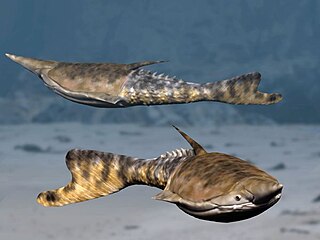
Pteraspididae is an extinct family of heterostracan vertebrates. It is an Early Devonian-aged family that contains the stereotypical, torpedo-shaped pteraspidids, such as the type genus, Pteraspis, and its close relatives Errivaspis and Rhinopteraspis, that are popularly thought to have actively swam about in the water column. The elongated rostral plate is thought to help with their hydrodynamic ability. Various genera are found in various marine and estuarine strata of Early Devonian Europe and North America.
Anchipteraspididae is an extinct family of heterostracan vertebrates restricted to Late Silurian and Early Devonian strata of Arctic Canada.





